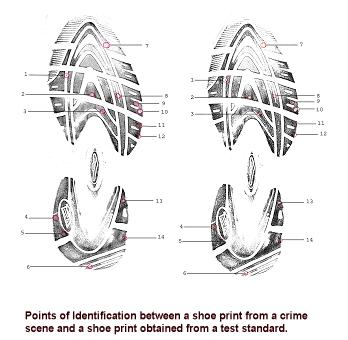Footwear track evidence can be very instrumental to the successful conclusion of a criminal investigation.Detailed examination of footwear impressions can help to link a specific piece of footwear to a footwear imprint as each shoe will have unique wear characteristics.

Photographing Footwear Evidence
Written by Dwane Hilderbrand
Taking quality examination photographs
When making quality examination photographs of the evidence prints, be sure to use the same numbered marker you used when you were showing the relationship of the print to the scene. In order for a footwear examiner to perform a quality examination, high-quality, close-up photographs are required. Since footwear evidence can come in two different forms—prints and impres-sions—the techniques of photography are slightly different. This can be easily obtained with a little time and patience. There are many types of cameras that are being used for crime-scene photo-graphy, ranging from 35 mm and 4 x 5 film cameras to digital cameras.
After the selection of the camera and the film or digital media, you will need to select an appropriate scale that will be present in all the photographs. This is very critical in order to allow for enlargement from the negative or image to make an exact duplicate of size (1:1). When no scale is utilized in the photograph, the examiner has no idea what the size of the real impression is. It then becomes difficult for the forensic photographer to print 1:1 scale photographs for examination purposes.
Types of footwear evidence
Footwear evidence can come in at least 3 forms, footwear outsole impression evidence, footwear insole impressions and footwear trace evidence.
Footwear outsole impression
Footwear outsole impressions are impressions left on an object that was caused by contact with a piece of footwear. These can left on the ground or raised surface by persons treading over it, left on doors or walls by persons attempting to kick or climb over a wall or even left on other persons after being kicked or stomped on.
Latent footwear outsole impressions:
Latent impressions are caused impressions that are not easily visible to naked eye. Such prints can be on many different surfaces such as floor tiles, concrete or even carpet. Latent impression may not be easily visible to the naked eye and its detection may require the use of additional specialized light sources such as portable UV lighting. Recovery typically includes photography as well as lifting with “gel” or “electrostatic” dust lifters.
Footwear Insole imprints
Footwear insole imprints are imprints left in the inside of footwear caused by contact from the person’s foot. Analysis of the insole imprints can be used to link a person(s) to a piece of footwear.
Footwear trace evidence
Footwear trace evidence is trace evidence that is recovered from footwear. Types of trace evidence that could be recovered include skin, glass fragments, body hair, fibres from clothing or carpets, soil particles, dust and bodily fluids.
The study of this trace evidence could be used to link a piece of footwear to a location or owner.
Detection of footwear evidence
Detection of impression in ambient lighting
Detection with forensic light sources
Detection with electrostatic lifting devices
Detection with chemical enhancement
COURSES IN FOOTWEAR EVIDENCE:

FEW LINKS:
Tire Tread and Tire Track Evidence: Recovery and Forensic Examination (Practical Aspects of Criminal & Forensic Investigations) Search Amazon.com for Footwear track evidence
Search Amazon.com for Footwear track evidence




